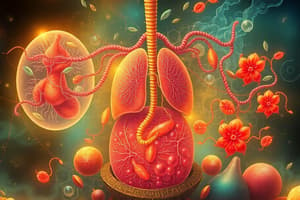Podcast
Questions and Answers
What is the main purpose of respiration in living organisms?
What is the main purpose of respiration in living organisms?
- To produce hormones
- To remove waste products
- To absorb nutrients
- To release energy from glucose (correct)
Aerobic respiration occurs in the absence of oxygen.
Aerobic respiration occurs in the absence of oxygen.
False (B)
What substance does anaerobic respiration produce in human muscle cells?
What substance does anaerobic respiration produce in human muscle cells?
lactic acid
In aerobic respiration, glucose reacts with oxygen to produce carbon dioxide, water, and ________.
In aerobic respiration, glucose reacts with oxygen to produce carbon dioxide, water, and ________.
What type of respiration is less efficient and produces less energy?
What type of respiration is less efficient and produces less energy?
Match the following types of respiration with their products:
Match the following types of respiration with their products:
Anaerobic respiration is the same in all organisms.
Anaerobic respiration is the same in all organisms.
Where does aerobic respiration primarily take place in the cell?
Where does aerobic respiration primarily take place in the cell?
What is the correct order of organization in multicellular organisms?
What is the correct order of organization in multicellular organisms?
Diffusion involves the movement of substances from areas of low concentration to areas of high concentration.
Diffusion involves the movement of substances from areas of low concentration to areas of high concentration.
What do cells need to survive?
What do cells need to survive?
Materials move in and out of cells through ________.
Materials move in and out of cells through ________.
Match the following cell types with their descriptions:
Match the following cell types with their descriptions:
Flashcards
Respiration
Respiration
A vital chemical process in living organisms that releases energy from glucose.
Aerobic Respiration
Aerobic Respiration
Respiration that uses oxygen to release energy from glucose, producing carbon dioxide and water.
Anaerobic Respiration
Anaerobic Respiration
Respiration that does not require oxygen, producing less energy than aerobic respiration.
Lactic Acid
Lactic Acid
Signup and view all the flashcards
Ethanol
Ethanol
Signup and view all the flashcards
Mitochondria
Mitochondria
Signup and view all the flashcards
Glucose
Glucose
Signup and view all the flashcards
Fermentation
Fermentation
Signup and view all the flashcards
Cells
Cells
Signup and view all the flashcards
Tissues
Tissues
Signup and view all the flashcards
Organs
Organs
Signup and view all the flashcards
Organ Systems
Organ Systems
Signup and view all the flashcards
Diffusion
Diffusion
Signup and view all the flashcards
Study Notes
Respiration
- Respiration is a crucial process for releasing energy from glucose (a sugar)
- This energy powers many cellular functions
- Respiration occurs in every living cell.
Aerobic Respiration
- Requires oxygen
- Occurs in mitochondria
- Glucose + Oxygen → Carbon Dioxide + Water + Energy
- More efficient than anaerobic respiration, releasing more energy
Anaerobic Respiration
- Does not require oxygen
- Less efficient than aerobic respiration, producing less energy
- Different products in different organisms
- In humans: glucose → lactic acid + energy (lactic acid buildup can cause pain)
- In microorganisms (e.g., yeast): glucose → carbon dioxide + ethanol + energy (process called fermentation, used to make beer)
Studying That Suits You
Use AI to generate personalized quizzes and flashcards to suit your learning preferences.



